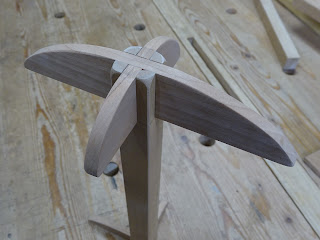In parts 1 and 2 of this series, the Irwin #2 and Clark Expansive / T&L Co. bits were featured. This time, it's the Irwin #22. Its form is very similar to the #2.
 |
| Irwin #2 at top, #22 bottom |
Unlike for the other two expansive bits, I've got both the long and short cutters for the #22. The two bits in the above picture have a lot of similarities. While they were probably made a few decades apart, they have the same thread on the lead screw, the same overall length and the same relative position of the main body's radial cutter. The main difference is how the adjustable arm is clamped.
 |
| The Irwin #22 close up |
 |
| Irwin #2 top, #22 bottom |
The #2 clamps the adjustable arm using a screw (turned from the front) that squeezes together the main body, that has a kerf cut into it, and this in turn pushes the dovetail of the adjustable arm into the dovetailed way of the main body. The #22 has a very different mechanism.
 |
| "Wheel" removed |
 |
| The lower edge of the wheel is in a wedge shape ... |
 |
| ... that matches a wedge shape where it resides in the main body |
When the screw is tightened (from the back side), the wheel is pulled down into its seat. The gear teeth on the wheel mesh with the teeth on the adjustable arm. The toothed edge of the adjustable arm has an angle that matches the wedge angle of the wheel. As the wheel gets pulled down into its seat, the adjustable arm is forced up into the dovetail way of the main body.
 |
As wheel gets pulled down (red arrow), adjustable arm is
forced against main body (yellow arrow) |
There seems to be poor machining of the mating surfaces of the adjustable arms and the main body. In the following pics, the long cutter is installed.
 |
| Right side showing gaps in the dovetailed ways |
 |
Left side showing some gaps at dovetail ways (red arrow), but also
it appears the adjustable arm is making contact with the main body at the yellow arrow,
which does not allow the dovetails to fully seat. |
I've been frustrated at attempts to eliminate the gap between the adjustable arm and the main body. After spending several hours over the last two days studying it and trying some judicious filing, I can't get the gap to close.
Here is what happens when I use the bit to bore a hole. I get into the cut several turns, and then things start bogging down.
 |
Using the small arm to bore (approx) 1 1/4" hole.
Shavings clogging the works. |
 |
| This is what's left when I pull out the bit and remove most of the debris |
I can't be certain that this is what starts the bit on the road to poor performance, but that's what I think it is. I'd love to be able to film the cutting action close-up, but that's far beyond my tech capabilities.
My thinking is that this model is simply a poor design that was poorly machined. In the next photos, look at how the adjustable arm is supported when making the larger diameters for each arm.
 |
| Short arm at minimum diameter setting: wheel contacts arm in center of arm |
 |
| Short arm at maximum diameter setting: wheel contacts arm only at right end of arm |
 |
| Long arm at minimum diameter setting (about 1.5"): wheel contacts arm in center of arm |
 |
Long arm at maximum diameter setting (about 3"): wheel contacts arm only at right end of arm
|
An indication of the poor support of the arms when at their max diameter setting is that I can jiggle the short arm when it is fully tightened. My thought is that with only a small part of the toothed edge of the adjustable cutter being supported, just a little torque can knock these cutters out of whack.
For comparison, here is a picture of the Irwin #2 with long cutter arm in place at maximum diameter setting. The arm is supported from its right end to where it exits the main body.
 |
| Irwin #2 at max diameter: arrows show where arm is supported by wedge |
I found a fix to the problem of the short cutter on the #22 jiggling even when tightened. By adding a 0.005" shim behind the cutter, the bit could be tightened sufficiently.
Bottom line is this: I don't think the #22 is a good design, nor was it machined well. I doubt I'll ever use it, as I can use the other two. But the cutters will fit into the T&L Co. bit (even with the teeth), so it might be worth keeping just for those parts.






























































